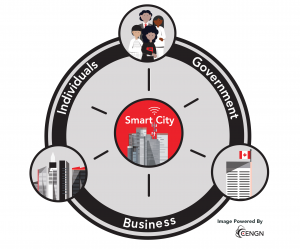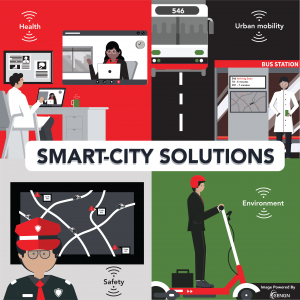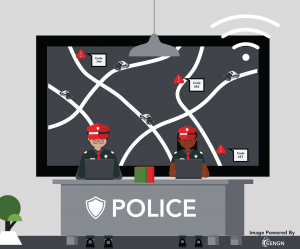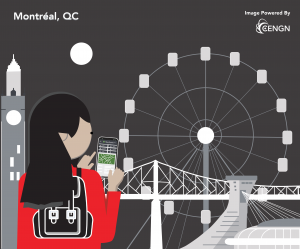More Innovation:
The Smart Cities of Tomorrow Enabled by 5G and IoT
Updated: January 24, 2022
Smart Cities, 5G, and IoT – It’s All Happening Now
As technology evolves faster than ever, it’s making it easier to transform concepts into reality. While many are busy working on space tourism or hyperloop transportation systems, a dramatic transformation unfolds right where most of us live.
We’re talking about smart cities.
The world is becoming increasingly urban, with 56.2 percent of the current population located in cities (Source: World Economic Forum). And, with the rise of urbanization, more problems follow, such as pollution, overwhelmed transit systems, public security, and healthcare systems.
Smart cities are the future of urbanism, taking advantage of advancements in network technology to develop a fully connected urban environment for the technology-driven society that is forming.
City innovators are looking to improve quality of life and solve urban issues by leveraging 5G-enabled technologies such as the Internet of Things (IoT) and artificial intelligence (AI). But building a smooth transition to a fully smart city requires a collaborative effort, involvement of local government bodies, private companies, academia, and not-for-profit organizations, to lead to a sustainable society – all driven by technology.
What is a Smart City?
Smart cities have an underlying framework that leverages IoT sensors, communication networks, real-time data, and other information and communication technologies to connect all aspects of the city. Data captured by sensors throughout the city are transported through high-speed networks and transformed into actionable information and insights. This information then drives automated technologies that fast-track processes and react immediately to changing environments.
Technology providers and developers design specific applications and solutions to interpret this influx of data and automatically respond to improve efficiency. This innovative technology could range from streamlining city traffic to automating building windows and air conditioning to control temperatures. Once validated, these apps are offered to municipal governments or directly to citizens and businesses for use. This last point is critical: a city can only become truly “smart” if the entire ecosystem of adopters buy in –individuals, organizations, and the city itself.

With this framework in place, the smart city improves the quality of life for citizens who engage with this digital environment through their daily affairs, like interacting with a store, entering their office space, or using a crosswalk. By automating the interactions of its citizens, a smart city can improve life in many ways.
Cities can incorporate smart technologies into multiple dimensions, from optimizing traffic flow with sensor-fueled traffic lights to streamlining services like trash collection by determining what type of trash to collect according to capacity or demand and optimizing pick-up routes for collection trucks.
All these innovations require advanced technologies to function. Namely, two are the backbone of future smart cities: IoT and 5G.
IoT and 5G: Propelling Cities into the Future
Mass deployment IoT is the foundation for modern smart cities, allowing multiple devices and other machines to communicate among themselves. This creates a network of automated cross-platform communication and intelligent interactions based on a constant real-time data flow. This large influx of data collected and exchanged by smart objects in the environment allows the network applications to “learn” and adapt to trends, events, and preferences, creating a smart ecosystem that continues to improve city processes.
For this reason, the future of smart cities is only as great as the technology that enables them. 5G represents a critical turning point in the evolution of smart cities. With its high-speed, low-latency, and higher capacity wireless connectivity, 5G handles a massive number of connections. This major leap in network speed and capacity allows industries to catch up with innovation, making it practical to deploy emerging technologies such as mass IoT deployments, Artificial Intelligence (AI), and Quantum Computing into our businesses and everyday life.

4G’s speed and capacity brought us to where we are today regarding mobile applications, navigation, and video. 4G is genuinely seen as the generation connecting man-to-machine with the smartphone and tablet.
However, 5G boasts a 100x increase in traffic capacity and network efficiency, a 10x decrease in end-to-end latency, and speeds over 600 times faster than the typical 4G speeds (Source: Canadian Wireless Telecommunications Association). That is why many see 5G as the machine-to-machine generation of technology, which warrants no human interaction; machines take actions according to sensor data.
The advanced connectivity features of 5G, such as high bandwidth and low latency fuel the improved machine-to-machine communication leading cities into the new era of IoT-enabled applications that improve services across the industry, including healthcare, transportation, safety, energy management, and many public services.
As technology advances, cities encounter many opportunities in which innovative solutions can reduce strains and improve sustainability.
Smart City Technologies and their Impact on Quality of Life
People may not be aware, but we incorporate smart technologies seamlessly into our daily lives, in every aspect and for the better. Some may acknowledge the impact smart home technologies have made, such as Amazon Alexa or Google’s whole portfolio of smart speakers, lights, cameras, apps, and tools.

These innovations are just the beginning and have already improved convenience, cost of living, and even safety, regarding our homes and daily routine. And, like someone’s house, the city can be optimized with smart technologies to improve all facets of life, including:
- Safety
- Health
- Environment
- Urban mobility
Living in a Safer and Smarter Urban Environment
Public safety is a primary target of smart cities, looking to improve life for citizens, the government, and law enforcement by reducing crime and improving emergency response times. For example, a McKinsey Global Institute study points out that smart technologies could help reduce crime by 30 to 40 percent and lead to 20 to 35 percent faster response times for emergency services (Source: McKinsey and Company).

Of course, technology alone won’t eradicate crime and guarantee safety, but it can contribute to more efficient use of resources to prevent and respond to threats. The Next Generation 911 (NG911) is just one example of a technology initiative that focuses on improving public safety. NG911 aims to disrupt the current 9-1-1 response system in place and find better ways to put citizens in contact with emergency responders. This includes working with voice, image, video, and text through digital channels, leveraging IoT and fast networks instead of the traditional analog phone lines used today.
Smart surveillance solutions, real-time crime mapping, and traffic signal pre-emption are other examples that enable authorities to track crime more efficiently and respond to them quicker. Police work driven by data offers citizens more security, fairness in authority accessibility and provides the city consistent emergency coverage according to necessity (Source: McKinsey and Company).
Integrating Health Tech into the City
Typically, the larger the city, the more difficult it is to manage because of environmental impact, logistics, and the sheer number of people. However, health technologies are increasingly being incorporated into municipalities to improve public wellness.
With faster networks connecting professionals, patients can schedule consultations via online video instead of an in-person appointment. For low-income communities, telemedicine is a lifesaver, cutting down on high transportation costs and allowing short-staffed health professionals to save time and see patients more often. This technology is already becoming more common to monitor patient conditions and alert physicians when an intervention is warranted. Perhaps the next step will be to use connectivity to measure individual health and the wellness of a whole urban population.
To properly account for a city population’s health and be ready for unexpected issues, officials can use data and analytics to track key indicators. For example, the community’s primary health issues, hotspots for an outbreak, groups with high-risk profiles, and optimize health campaigns and interventions with precision. This includes messages about vaccination, flu shots, and sanitation.
Interested in learning about how 5G Is contributing to a healthier tomorrow? Check out this article on the 6 Ways 5G Is Improving Our Healthcare System here.
Smart Cities are Good for the Environment
Growing urban centres have led to increased energy consumption, pollution, and waste, threatening sustainability, especially concerning the environment. However, eco-friendly mobility solutions, dynamic energy and water pricing and management, and air quality sensors can help reduce the environmental impact.

Electric vehicles are becoming more popular by the minute due to their low carbon footprint. Even local transportation is taking note as electric scooters and bikes – also known as micromobility fleets – are another option to drive sustainability in urban centres. Micromobility fleets encourage sharing, alleviate public transport systems for short distances, and lead to a 51% decrease in urban carbon emissions (Source: EY).
Smart cities are already finding ways to implement e-scooters and bikes to make sense for end-users. Enabled by IoT, micromobility fleet apps connect pedestrians in need of transportation with fleet operators and city transit systems to ensure they choose the most efficient method of mobility available. Beyond sustainability, all parties receive an influx of rich data insights concerning transport usage and traffic around the city.
Energy and water consumption tracking is another tool that reduces consumption and increases conservation efforts. Using IoT sensors deployed in meters allows real-time messages to be sent to residents showing them how much energy they’ve used. As a result, incentivize reduced consumption and pave the way for reward programs that encourage more environmentally friendly behaviour. Additionally, the city can deploy sensor technology and artificial intelligence to detect and predict where there might be leaks or defects in water pipes, which can save millions of dollars in resource waste and damages needing repair (Source: United States Environmental Protection Agency).
Interested in how smart technologies can improve water management? Read our blog, 5G Climate Change: 4Ways 5G is Helping the Environment.
In terms of data collection, air pollution sensors and analytics help municipal governments identify points of heavy carbon emissions and their causes. This information can then be acted on, sharing data in real-time to take proactive measures, preventing a hike in pollutant concentration rather than waiting until pollution peaks. An example would be incorporating sensor technology and automation into manufacturing processes, allowing for system-wide data analysis. That will determine which manufacturing process produces the most significant carbon footprint and can be optimized towards a more eco-friendly alternative.
Smart-City Technologies Optimizing Urban Mobility and Reducing Commute
Nothing is more valuable than time, and that’s why worsening urban mobility is becoming a prominent issue in growing cities.
According to an international traffic congestion ranking conducted by TomTom, in 2020, Canadians in Vancouver spent a total of 105 hours stuck in traffic over a year, while in cities like Toronto and Montréal, commuters lost between 80 and 82 hours in traffic (Source: TomTom International BV).
Improving the daily commute is crucial to the quality of life. For example, a 10 percent drop in commute time could increase productivity, boosting GDP by $270 million in Vancouver and $535 million in Montreal (Source: Canadian Wireless Telecommunications Association).
Currently, commuters can leverage mobile apps, sensors, and cameras to receive real-time traffic information. However, with 5G networks, the exchange of data will become more powerful, with faster transmission speeds and a capacity to accommodate more devices capable of alleviating traffic problems in real-time through machine-to-machine communication of transit systems and smart traffic lights.
Additionally, this superior network of connected devices enables city maintenance to better respond to problems and breakdowns to avoid significant delays that summed to the whole, optimizes overall traffic flow.
Smart Cities in Canada
Whether it’s a thousand citizens or over a million, all cities should be taking steps to incorporate smart technology. Frontrunner cities facilitate collaboration between the municipal government, businesses, and citizens to drive innovation and integrate solutions into their infrastructure.
You can find these cities of the future around the globe, with Seoul and European cities considered early adopters of the smart framework, followed by the likes of Dubai, Singapore, and U.S. city standouts; New York, Los Angeles, Dallas, and San Francisco, (Source: Tech Republic). As 5G continues its rapid deployment, the swift development of smart cities is becoming the norm worldwide.
In Canada, multiple municipalities are making the jump, with federal programs such as the “Smart Cities Challenge” encouraging the movement (Source: Infrastructure Canada). Here, we’ve listed two prominent Canadian metropolitan areas that have made massive progress towards becoming integrated smart cities – both using 5G and IoT to help.
Montréal, Quebec
As the winner of Infrastructure Canada’s 2019 Smart Cities Challenge, Montréal set priorities to improve the city’s mobility and access to food for vulnerable populations. The basis of the city’s plan is built on providing data hubs for municipal officials and organizations to analyze data and make decisions based on their insights.

In terms of urban mobility, the city aims to offer citizens a more efficient and user-friendly experience and reduce their dependence on cars.
With the development of a new digital platform, Montrealers have a single source of information for all available transportation modes, such as public transport, micromobility fleets, taxis, app-based transportation, and walking. Additionally, Montreal wishes to take advantage of city data to facilitate better transport according to the needs of different neighbourhoods, communities, and its residents.
When it comes to food access, the city proposes establishing a local integrated food system to pool together infrastructure and resources that are already in place for local food production, distribution, storage, and processing.
By creating a technology platform to manage inventory, sales, food donations, and delivery, participating organizations can increase their collective buying power for local fresh foods, reduce waste and decrease operating costs. The project also involves the construction of urban greenhouses that recovers industrial heat from landfills.
Vancouver, British Columbia
Vancouver is also leading the way in smart cities, adopting new technologies and leveraging data to improve connection and convenience for its population. For example, the city already boasts free wi-fi in 755 public spaces and enables online bike-sharing services to reduce cars in the city centre. Additionally, with the VanConnect App, citizens can connect with the city, interact with what is happening around them, receive news, file reports of crimes and issues, and look up community information (Source: City of Vancouver).
One of Vancouver’s main objectives is to become a smart mobility leader. Smart IoT traffic sensors already enable smooth route planning and quick response by emergency respondents – a step toward enabling smart cities. The next step is to leverage advanced data, analytics, and autonomous shuttles to develop Canada’s first collision-free corridors. This will enhance mobility, user experience, and safety for citizens across the city.
A Future of Great Cities
As smart technologies become increasingly sophisticated and available, we can expect more and more smart cities to emerge and innovations to become social norms. The 5G revolution enables innovative solutions like AI, Massive IoT, and communication tools that serve as the foundation for smart cities’ game-changing solutions today.
These solutions come with the expectation that cities around the globe can expect a higher quality of life regardless of their size. In 2050, growing urban areas in developing countries project to have a population of 5.2 billion (Source: Visual Capitalist), and 80 percent of future economic growth for the developing world will occur in these areas. Having the right solutions in place will ensure the populations of these communities grow sustainably, with access to improved utilities, health, safety, transportation, education, and communication networks.
As the former mayor of Denver, CO, Wellington E. Webb, once said: “The 19th century was a century of empires, 20th century was a century of nation-states, and the 21st century will be a century of cities.”
In the same way as those around the world, Canadian cities should continue to push for more smart integration across the country to improve quality of life and drive sustainability. Municipal governments must work closely with businesses and the community to find innovative solutions for issues that afflict citizens today. And to do so, choosing the right tools is vital, integrating technologies such as 5G, IoT, and AI while supporting the growth of smart cities.
Are you interested in hearing more about 5G, IoT, and other innovative technologies?
Download our “Next Generation Network Imperative” Whitepaper to find out what the future of next-generation technologies will look like.
The International Data Corporation (IDC), a world-renowned global market intelligence firm, was commissioned to complete this study.









